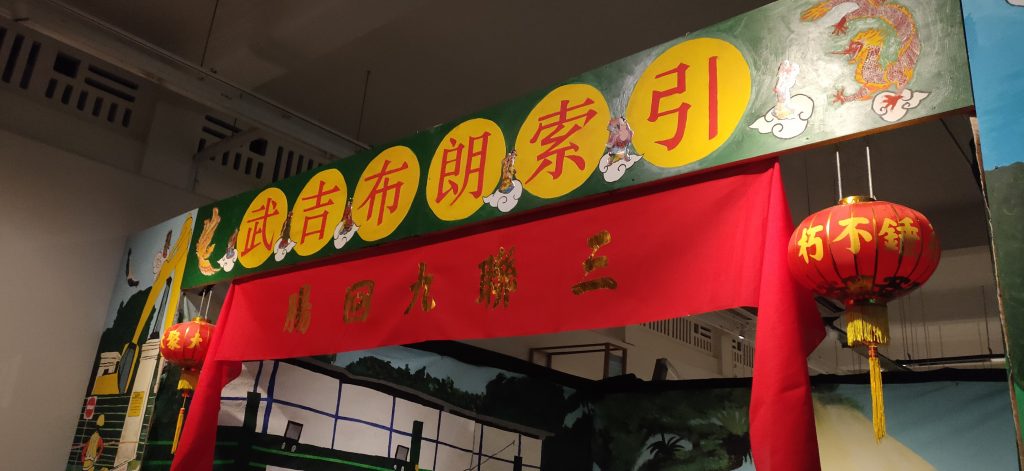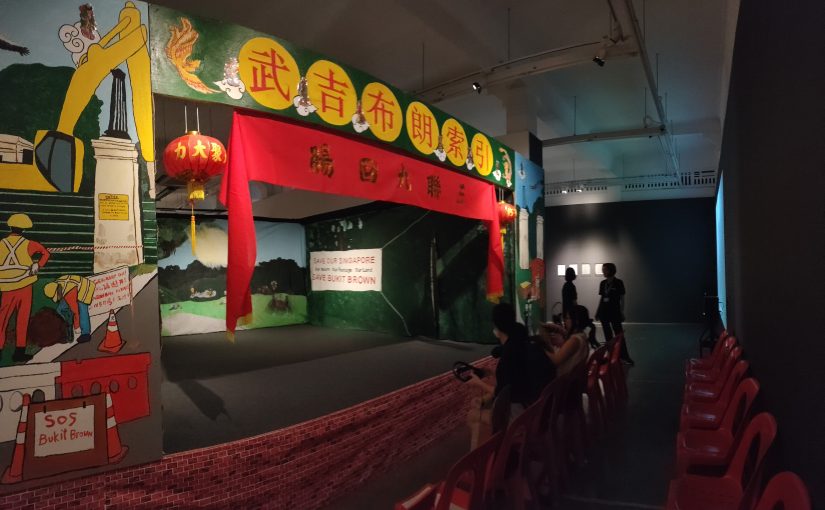Bukit Brown Index #132: Triptych of the Unseen was exhibited at Gillman as part of Singapore Biennale 2019. It is a large scale installation consisting of a stage, a three part video performance and an archival collection covering the uproar around the redevelopment and destruction of Bukit Brown Cemetery back in 2011 to 2014.
The set up was a familiar sight, adopted from traditional Chinese Street opera often performed during the Hungry Ghost Festival. The significance of it is that it is a common space where the dead and living meet to enjoy, in this case, as the writing on the red banner connotes, the nostalgic or tragic saga of Bukit Brown. It is a place of tribute and offering to the visiting dead; perfect choice in setting.

I think Post Museum, the creators of this artwork, has achieved their aim “to encourage and support a thinking and pro-active community in this piece.” In an interview from OnCurating, they were asked about where they think they stand between the centre(state) and the periphery(independent). Their answer spoke about who public space belongs to? Saying that Singapore adopted a place management strategy to inject ‘heart and soul’ into the city. The strategy had been used by other cities such as New York and Paris and is referred to as “placemaking”. It is directed to developing participatory communal places and improving quality of life for its residents. It is after this point that their response really raised questions for me. Post Museum raised a point that placemaking should not be exclusive to urban planners and the government, it should be a shared decision. Because we are all enagaged with said space, thus are always participating in the placemaking process. Post museum may be referring to their artistic practice but I find it prevalent in this project.
I picked to write about this work because it is closely related to my idea for FYP; revolving around culture, heritage and identity. Why heritage should be preserve and how it ties to belonging? Bukit Brown cemetery may house many graves of pioneers such as Tan Lark Sye (1897-1975), entrepreneur and co-founder of Nanyang University and Chew Joo Chiat (Joo Chiat estate) but why is it important to conserved them? What reasons is there to be upset other than the fact that digging graves is disrespectful? Triptych of the Unseen first featured at Substation in 2018 and the artistic director then spoke of heritage as a form of control. He said “heritage really largely is not just about the past, but the way you define the past also determines your present and future.” It is a deceivingly harmless topic for one so political. (at least in Singapore) I wish to go into more detail in my next post about my FYP ideas so the discussion shall end here.

The meat of the story is literally in the content of the work. The three part video performance, taking on the perspectives of the ‘Ghost,’ ‘Activist’ and ‘Bureaucrat’. It depicts the struggle of space in Singapore through moral contradictions of the three characters and their relationship with each other. The choice for implementing the virtual reality setting was to “trap the spectators and performers within this ‘unseen’ tragicomedy where they ‘are condemned’ to watch and perform this act endlessly.” When you enter the virtual space, you are sat in within an ‘ghost’ audience as everyone is wearing a opera mask. “Unknowingly we all become victims to the priorities embedded in the grammar of the city.”
Reference:
https://www.singaporebiennale.org/art/post-museum
